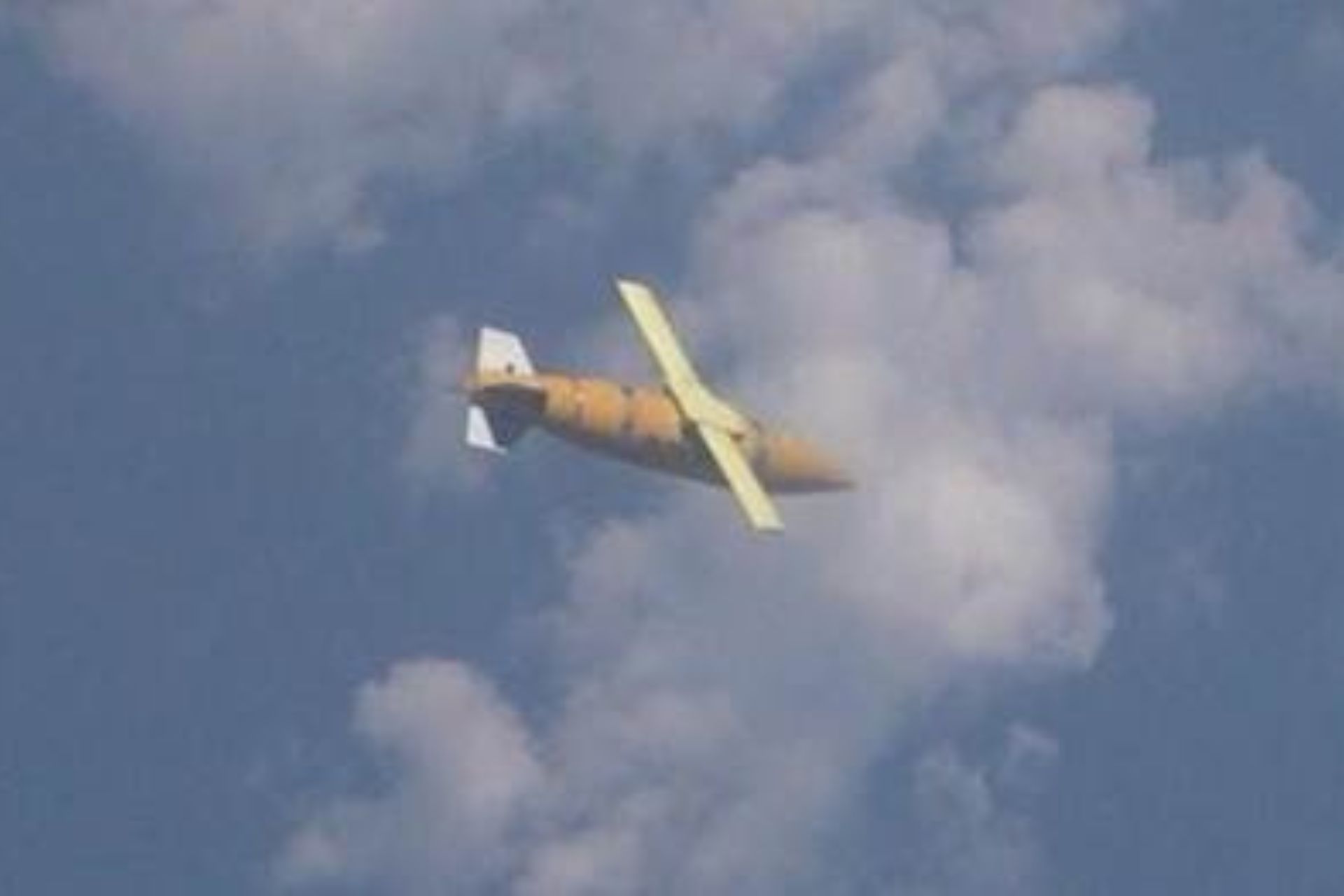India’s New Gaurav Glide Bomb Dropped from a Su-30MKI Fighter Confirms Long-Range Strike Capabilities

{loadposition bannertop}
{loadposition sidebarpub}
India’s Defence Research and Development Organisation (DRDO) successfully conducted trials of the Gaurav Long-Range Glide Bomb (LRGB) between April 8 and 10, 2025. This new 1,000 kg class munition, developed indigenously, was tested from a Su-30 MKI fighter aircraft operated by the Indian Air Force (IAF). The official announcement, made on April 11 by the Ministry of Defence, noted that the weapon achieved a range close to 100 kilometres with high accuracy, confirming its potential to conduct long-range precision strikes while keeping the launch platform out of reach of enemy air defences.
Follow Army Recognition on Google News at this link
During the trials, the system was tested under various warhead configurations and at multiple hard points on the aircraft, with a land-based target located on an island (Picture source: Indian MoD)
The Gaurav glide bomb is the result of a collaborative effort between the Research Centre Imarat, the Armament Research and Development Establishment, and the Integrated Test Range in Chandipur. This development highlights India’s ongoing efforts to enhance its self-reliance in precision strike technologies. During the trials, the system was tested under various warhead configurations and at multiple hard points on the aircraft, with a land-based target located on an island. According to DRDO, these tests represent a step toward operational integration of the weapon within the IAF.
The program was carried out with support from key Indian industry partners under a development-cum-production model, including Adani Defence Systems & Technologies and Bharat Forge, along with a network of medium-sized enterprises and small businesses. Certification and quality assurance processes were handled by the Centre for Military Airworthiness and Certification (CEMILAC) and the Directorate General of Aeronautical Quality Assurance (DGAQA), two specialist agencies in India’s defence aviation sector.
Alongside the Gaurav tests, India also conducted successful trials of the Smart Anti-Airfield Weapon (SAAW), a lighter glide bomb weighing approximately 125 kg, designed to neutralize military infrastructure such as runways, hardened shelters, and bunkers. Also equipped with a precision guidance system, the SAAW demonstrated similar range capability, reaching up to 100 kilometres depending on release conditions. Already integrated on platforms such as the Jaguar and Su-30 MKI, it is also planned for deployment on the Rafale and Tejas MK1A aircraft. Three separate firing trials were conducted under varying conditions, all deemed successful, and the weapon is expected to be inducted shortly.
In a global context marked by rapid advancements in long-range strike technologies, glide bombs are emerging as a strategic solution increasingly adopted by various countries. Unlike traditional free-fall bombs, glide bombs are equipped with aerodynamic surfaces—such as deployable wings or tail fins—that enable them to travel extended distances after release from high altitude and high speeds. Once deployed, they primarily rely on GPS or inertial navigation systems, sometimes enhanced with laser or electro-optical terminal guidance, to achieve precise target engagement, including in contested environments.
These munitions serve as an intermediate capability between conventional bombs and cruise missiles. They offer extended reach, high accuracy, and lower production costs compared to powered missile systems. For instance, the U.S. JDAM-ER kit, which converts an unguided bomb into a glide weapon, costs between USD 20,000 and 40,000, whereas cruise missiles can cost several million dollars per unit. Systems such as the JDAM-ER and GBU-39 Small Diameter Bomb can exceed ranges of 100 kilometres when released from optimal altitude.
In a global context marked by rapid advancements in long-range strike technologies, glide bombs are emerging as a strategic solution increasingly adopted by various countries (Picture source: Indian MoD)
Historically, the concept of glide bombs is not new. Several countries—including the United States, Russia, China, France, and Turkey—have invested in their development. Examples include Russia’s KAB-500 series, the UMPK kits added to FAB-500-M62 bombs in Ukraine, and France’s AASM Hammer, supplied to Kyiv for precision strikes.
The growing appeal of glide bombs lies in several strategic advantages: the ability to strike from beyond the range of enemy air defences, compatibility with various aerial platforms, configurable warheads, and the potential to limit collateral damage due to their accuracy. Their relatively low cost and scalability also make them suitable for mass deployment to saturate adversary defences.
However, these systems are not without limitations. Their unpowered nature means their range depends on the altitude and velocity of the launch aircraft, which can affect operational flexibility. In addition, reliance on satellite navigation makes them vulnerable to electronic warfare tactics such as GPS jamming or spoofing, as seen in current conflicts. Advanced air defence systems like the Patriot or S-400 may also intercept glide bombs under certain conditions.
The spread of this technology raises broader concerns about regional stability and security. The acquisition of glide bomb capabilities by mid-level powers or non-state actors could shift the balance in asymmetric conflicts. Future enhancements, including the integration of artificial intelligence for dynamic targeting and the development of hypersonic glide bombs, are likely to further change the nature of aerial warfare.
The successful trials of the Gaurav glide bomb are consistent with the broader global trend of investing in indigenous precision-guided munitions. They underscore India’s intention to strengthen its strategic autonomy in advanced strike capabilities while reducing the exposure of its combat assets. These developments are expected to provide the Indian Air Force with a more flexible and responsive arsenal, better suited to address evolving regional security challenges.

{loadposition bannertop}
{loadposition sidebarpub}
India’s Defence Research and Development Organisation (DRDO) successfully conducted trials of the Gaurav Long-Range Glide Bomb (LRGB) between April 8 and 10, 2025. This new 1,000 kg class munition, developed indigenously, was tested from a Su-30 MKI fighter aircraft operated by the Indian Air Force (IAF). The official announcement, made on April 11 by the Ministry of Defence, noted that the weapon achieved a range close to 100 kilometres with high accuracy, confirming its potential to conduct long-range precision strikes while keeping the launch platform out of reach of enemy air defences.
During the trials, the system was tested under various warhead configurations and at multiple hard points on the aircraft, with a land-based target located on an island (Picture source: Indian MoD)
The Gaurav glide bomb is the result of a collaborative effort between the Research Centre Imarat, the Armament Research and Development Establishment, and the Integrated Test Range in Chandipur. This development highlights India’s ongoing efforts to enhance its self-reliance in precision strike technologies. During the trials, the system was tested under various warhead configurations and at multiple hard points on the aircraft, with a land-based target located on an island. According to DRDO, these tests represent a step toward operational integration of the weapon within the IAF.
The program was carried out with support from key Indian industry partners under a development-cum-production model, including Adani Defence Systems & Technologies and Bharat Forge, along with a network of medium-sized enterprises and small businesses. Certification and quality assurance processes were handled by the Centre for Military Airworthiness and Certification (CEMILAC) and the Directorate General of Aeronautical Quality Assurance (DGAQA), two specialist agencies in India’s defence aviation sector.
Alongside the Gaurav tests, India also conducted successful trials of the Smart Anti-Airfield Weapon (SAAW), a lighter glide bomb weighing approximately 125 kg, designed to neutralize military infrastructure such as runways, hardened shelters, and bunkers. Also equipped with a precision guidance system, the SAAW demonstrated similar range capability, reaching up to 100 kilometres depending on release conditions. Already integrated on platforms such as the Jaguar and Su-30 MKI, it is also planned for deployment on the Rafale and Tejas MK1A aircraft. Three separate firing trials were conducted under varying conditions, all deemed successful, and the weapon is expected to be inducted shortly.
In a global context marked by rapid advancements in long-range strike technologies, glide bombs are emerging as a strategic solution increasingly adopted by various countries. Unlike traditional free-fall bombs, glide bombs are equipped with aerodynamic surfaces—such as deployable wings or tail fins—that enable them to travel extended distances after release from high altitude and high speeds. Once deployed, they primarily rely on GPS or inertial navigation systems, sometimes enhanced with laser or electro-optical terminal guidance, to achieve precise target engagement, including in contested environments.
These munitions serve as an intermediate capability between conventional bombs and cruise missiles. They offer extended reach, high accuracy, and lower production costs compared to powered missile systems. For instance, the U.S. JDAM-ER kit, which converts an unguided bomb into a glide weapon, costs between USD 20,000 and 40,000, whereas cruise missiles can cost several million dollars per unit. Systems such as the JDAM-ER and GBU-39 Small Diameter Bomb can exceed ranges of 100 kilometres when released from optimal altitude.

In a global context marked by rapid advancements in long-range strike technologies, glide bombs are emerging as a strategic solution increasingly adopted by various countries (Picture source: Indian MoD)
Historically, the concept of glide bombs is not new. Several countries—including the United States, Russia, China, France, and Turkey—have invested in their development. Examples include Russia’s KAB-500 series, the UMPK kits added to FAB-500-M62 bombs in Ukraine, and France’s AASM Hammer, supplied to Kyiv for precision strikes.
The growing appeal of glide bombs lies in several strategic advantages: the ability to strike from beyond the range of enemy air defences, compatibility with various aerial platforms, configurable warheads, and the potential to limit collateral damage due to their accuracy. Their relatively low cost and scalability also make them suitable for mass deployment to saturate adversary defences.
However, these systems are not without limitations. Their unpowered nature means their range depends on the altitude and velocity of the launch aircraft, which can affect operational flexibility. In addition, reliance on satellite navigation makes them vulnerable to electronic warfare tactics such as GPS jamming or spoofing, as seen in current conflicts. Advanced air defence systems like the Patriot or S-400 may also intercept glide bombs under certain conditions.
The spread of this technology raises broader concerns about regional stability and security. The acquisition of glide bomb capabilities by mid-level powers or non-state actors could shift the balance in asymmetric conflicts. Future enhancements, including the integration of artificial intelligence for dynamic targeting and the development of hypersonic glide bombs, are likely to further change the nature of aerial warfare.
The successful trials of the Gaurav glide bomb are consistent with the broader global trend of investing in indigenous precision-guided munitions. They underscore India’s intention to strengthen its strategic autonomy in advanced strike capabilities while reducing the exposure of its combat assets. These developments are expected to provide the Indian Air Force with a more flexible and responsive arsenal, better suited to address evolving regional security challenges.





